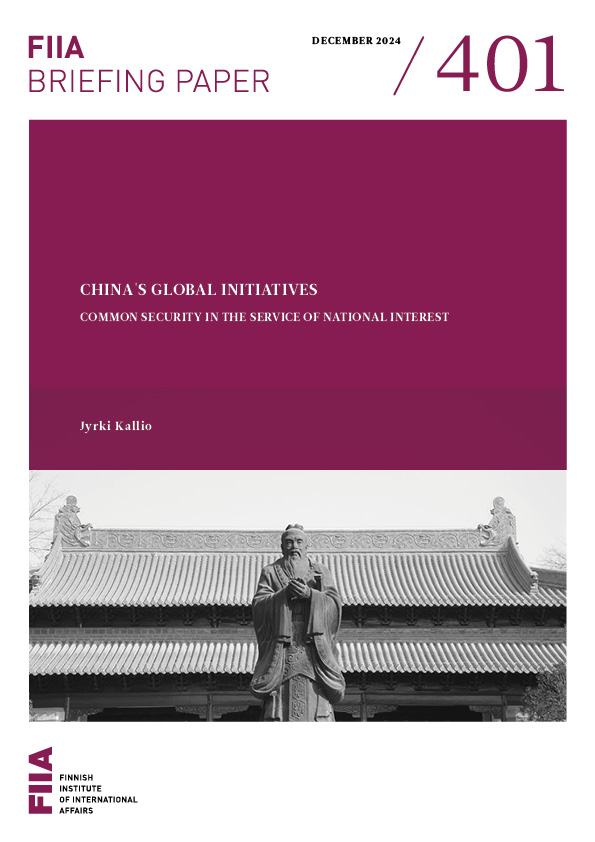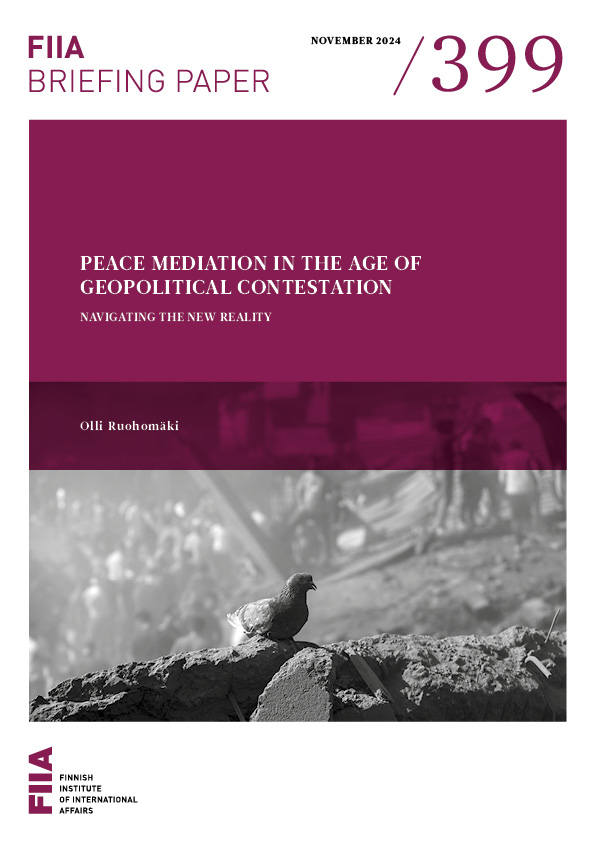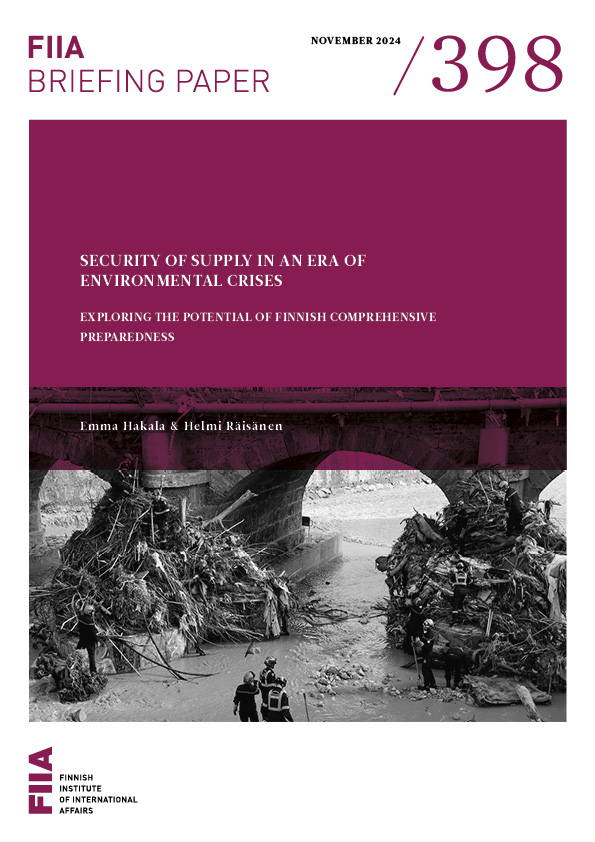China is challenging the regional balance of power in East Asia through a military buildup and an increasingly assertive foreign policy. The US is forced to find the right balance between cooperating with China while benefiting from its economic rise, and countering China’s regional reach by carrying out its self-declared “pivot” to Asia in spite of domestic and budgetary constraints.
With just over one year in office, Japan’s Prime Minister Shinzō Abe has received wide domestic support for his ambitious plans to revive Japan’s economy through his threefold policy of Abenomics. At the same time, however, he has implemented a number of significant policies in the defence and security sphere.
In response to China’s military rise, the Abe administration increased and recalibrated the defence budget. Furthermore, in order to reinforce the alliance with the US, the government approved the creation of a US-style National Security Council, passed a Secrecy Bill, and aims to reverse Japan’s self-imposed ban on exercising the right to collective self-defence.
Under the banner of “proactive pacifism”, the Abe cabinet is seizing the momentum caused by the changing regional power dynamics in order to edge closer towards “breaking away from the postwar regime”. A proposed revision of Japan’s constitution, unchanged since 1947, symbolizes the ruling Liberal Democratic Party’s (LDP) objective to bring about a more autonomous role for Japan both in the security alliance with the US and as an international actor.
As the first Japanese Prime Minister since 2006 to do so, Shinzō Abe paid homage to his country’s war dead at the Yasukuni shrine in Tokyo on December 26, 2013. The visit sparked strong reactions in neighbouring China and South Korea, where the shrine is strongly associated with Japan’s militaristic and expansionist past. Just before the visit, the Abe administration launched Japan’s first National Security Strategy (NSS), in which the cultivation of “love for the country” is mentioned as one means of strengthening the domestic foundation of national security. Abe himself strongly believes in the need to revive “traditional values”, patriotism and civic pride as a way to overcome Japan’s contemporary challenges. The Yasukuni visit is therefore certainly in line with Abe’s image as a hawkish politician and a staunch conservative.
More importantly, however, the visit symbolized Japan’s current attempts to redefine its position as a regional power in the light of the changing power dynamics in East Asia. China is challenging the US as a hegemonic regional power, and is adopting an increasingly assertive position vis-à-vis East Asian states over territorial disputes. The US aims to retain its central role as a power broker in the region by announcing a rebalancing of its military capabilities towards Asia. Fully aware of the fallout of the Yasukuni visit for regional relations, Abe aimed to drive home a message to domestic audiences that Japan will counter China’s powerful ascendancy as a regional power. In particular, the visit can be seen as a direct response to Beijing’s establishment in late November of an Air Defence Identification Zone (ADIZ) in the East China Sea covering the Japan-controlled Senkaku Islands.
Furthermore, defying US pressure to avoid visiting the shrine, Abe aimed to underline his resolve to place Japan further on the road towards “normalcy”, in a stronger yet more equal alliance with the US and with a less restrained international role for Japan.
Shinzō Abe’s policies during the past year under the banner of “proactive pacifism” underscore an ongoing shift in Japan’s security and defence policy. This briefing paper surveys Japan’s current policies aimed at strengthening military deterrence and bolstering the security alliance with the US. It argues that increasing Japan’s autonomy within the alliance with the US is an additional important domestic driver of Abe’s policy. The current changes, however, do not represent a recent and radical shift, but should be seen as the continuation of a gradual adjustment of defence policy and alliance politics. The Abe administration is seizing the momentum caused by the changing regional power dynamics in order to edge closer towards breaking away from the “post-war regime”, symbolized by the aspiration to revise the constitution.
“Restoring Japan”: reviving the economy, countering China
In late December 2013 Abe completed the first year of his second term in office as Japan’s Prime Minister. Japan’s electorate gave Abe its vote of confidence to proceed with his self-proclaimed mission to “take Japan back to the centre stage of the world” after the general elections of December 2012. In the span of one year Abe made no secret of his intentions to accomplish that ambition.
As Prime Minister, he immediately launched his Abenomics, a bold plan for an economic policy consisting of the “three arrows” of monetary easing, fiscal stimulus, and structural reforms aimed at achieving long-term growth. A few months later, Abe announced the decision that Japan would join the Trans-Pacific Partnership negotiations for a free trade agreement between twelve countries in the Pan-Pacific region, with the exception of China. Abe was furthermore successful in lobbying for the right to host the 2020 Olympics in Tokyo, which is expected to give an additional stimulus to Japan’s economy to the point of being labelled a “fourth arrow” of Abenomics.
But the attempts to revive Japan’s economy are accompanied by a number of equally striking and frequently controversial policies in the security sphere. Japan undoubtedly feels threatened in its region by China’s military build-up. China’s disclosed defence budget (in US dollars) has grown over five-fold in the course of ten years, and, with the exception of 2010, has shown a double-digit growth each year between 1989 and 2013. In 2012 China’s defence budget was around 102 billion USD officially, but was believed to be closer to 120 billion. More importantly, it is China’s increasingly forceful stance over its territorial claims to the Japan-controlled Senkaku Islands, called Diaoyu in China, that is the direct cause of Japan’s reaction. In the words of the recently published NSS, “China has taken actions that can be regarded as attempts to change the status quo by coercion based on their own assertions, which are incompatible with the existing order of international law, in the maritime and aerial domains, including the East China Sea and South China Sea”.1
[caption id="attachment_84073" align="alignleft" width="768"] Shinzō Abe was the first Japanese Prime Minister in more than seven years to visit the Yasukuni shrine in Tokyo. Photo: Bart Gaens.[/caption]
Shinzō Abe was the first Japanese Prime Minister in more than seven years to visit the Yasukuni shrine in Tokyo. Photo: Bart Gaens.[/caption]
In the fiscal year 2012, Japan scrambled fighter aircraft to monitor Chinese planes on a total of 306 occasions2, and already did so 287 times between April and December 2013.3 According to Japanese Foreign Ministry figures, between September 2012 and November 2013 over 240 Chinese vessels entered Japan’s territorial seas. This has aroused fears in Tokyo of Chinese attempts to establish effective control over the uninhabited Senkaku Islands. For Abe, the only way Japan can stop China from challenging Japanese effective control over the islands is by showing “physical force” rather than through negotiations, as he argues in a new edition of his bestselling book Towards a Beautiful Country.4
Japan’s intentions to toughen its posture translate into a higher defence budget. Although military expenditure only amounts to roughly 1% of GDP, Japan has the fifth highest defence budget in the world. In the fiscal year 2013 defence-related expenditure went up in real terms for the first time in eleven years. The budget for 2014 reveals an increase of 2.8% compared to 2013. The enlarged defence budget, amounting to 47.5 billion USD or around 5% of the total national budget, is of particular symbolic importance as it confirms a new trend in increased defence spending. At least as significant is the recalibration of military spending in terms of quality and purpose. Japan is investing in the development of amphibious capability in order to respond to attacks on remote islands. More emphasis is being placed on transport, rapid deployment mobility, and air and sea superiority. Also eye-catching is the attention being paid to early warning and surveillance activities in the waters and airspace around Japan, particularly in the Southwestern region. To achieve these goals, Japan is purchasing surveillance drones, Osprey aircraft, fighter jets and amphibious vehicles.
Furthermore, increased cooperation with the US in military technology development has led to the proclaimed revision of the “Three Principles of Arms Exports”. These principles, in place since 1967, in practice constitute a self-imposed ban on the joint development and export of weapons or military technology. The ban has included the export of components manufactured in Japan and used in the production of arms. In March 2013 the Abe administration decided on an exception to the ban in order to allow Japan to export equipment for the US-produced F-35 fighter jet. The NSS officially called for a comprehensive revision of the Three Principles.
Rebalancing the US-Japan alliance
In addition to increased defence spending, Japan aims to strengthen cooperation with the US. With a view to countering China’s military buildup and Beijing’s intensifying maritime claims in the region, the US aims to bolster its alliance with regional partners. The alliance with Japan plays a pivotal role here. Abe has responded to US calls for tightening military and security cooperation with the US. This goes hand in hand with a stronger and more autonomous role for Japan in the US-Japan security alliance, a move much welcomed in the US. Three key courses of action are the result, namely the creation of a National Security Council, the passing of a much-contested Secrecy Bill, and the declared aim to engage in collective self-defence.
First, US-Japan collaboration has led to an increased need to share political as well as technical intelligence. The Abe administration’s decision to create a National Security Council (NSC) based on the US model is intended to allow for speedier and more centralized decision-making, but also to lead to more effective cooperation with the US. The hurried and controversial passing in the Japanese Diet of the “Designated Secrets Protection Bill” is closely related to the NSC. In broad terms, it aims to tackle Japan’s image as a “spy heaven”, a country lacking a strong state secrecy law. Its main aim, however, is to facilitate intelligence sharing with US agencies. The US formerly only shared intelligence with Japanese government offices that were covered by stricter secrecy legislation such as the Ministry of Defence and the Self-Defence Forces (SDF). The NSC as a centralized and overarching organization necessitates tighter secrecy rules in order to smoothen the information exchange with the US.5 The law therefore broadens the categories of information to which secrecy applies, expands the government offices that can designate state secrets, and increases the penalties for those violating the law. The bill remains strongly contested because of its lack of transparency and its vague definition of what constitutes a secret, the absence of a supervisory organ monitoring information security, and possible conflicts with the public’s right to know.
A third element aimed at smoothening cooperation with the US is collective self-defence, particularly ahead of the scheduled revision, the first since 1997, of the US-Japan Security Alliance guidelines, to be completed by the end of 2014. Exercising the right to collective self-defence would allow Japan to come to the aid of allied countries in maritime conflicts, intercept missiles aimed at the US, or use force to protect military forces of third countries which, together with Japan, participate in collective security operations. In practice, it would allow Japan’s SDF much more freedom of movement to “proactively” engage in UN-run peacekeeping missions. At least as importantly, however, it would significantly enhance collective security cooperation with the US.
The current debate on collective self-defence is closely tied in with Japan’s constitution. As is well known, the constitution renounces war as a sovereign right and prohibits military forces that would enable war. Nevertheless, the text has always been interpreted as allowing Japan the right to self-defence and to maintain “Self-Defence Forces” in order to be able to take the minimally necessary measures to defend the country. An additional interpretation has been that Japan is not allowed to automatically exercise the right to collective self-defence.
For Abe, lifting the self-imposed restrictions on the right to exercise collective self-defence, through constitutional reinterpretation or through textual amendment, means increased deterrence and also contributes to a more equal security relationship with the US. In view of the divisions among policy-makers and public opinion alike, Abe will most likely first seek to change the current interpretation of the constitution in order to allow for collective self-defence. Abe’s appointment of an official said to be pro-reinterpretation as Director-General of the Cabinet Legislation Bureau, the institution generally seen as being in charge of constitutional interpretation, seems to confirm this view.
Edging closer to a more autonomous Japan?
The current path that Japan is taking in terms of defence and security can partly be seen as the continuation of an older process. The 2010 National Defence Program Guidelines (NDPG) had already launched the concept of a Dynamic Self-Defence Force, aiming to have more flexible and active capabilities and displaying a higher degree of military deterrence. Close cooperation with the US in the development of a Ballistic Missile Defence system started in 1999, and so-called interoperability has only increased since the mid-2000s. This has led to a gradual process renegotiating Japan’s “Three Principles on Arms Exports”. In fact, exceptions to the ban to allow for collaboration with the US were approved as early as 1983 and 2004. In 2011 the government by the current opposition party, the Democratic Party of Japan (DPJ), further deregulated the ban to allow for joint development of fighter planes with the US. The latest adaptation and calls for review are in line with this longer-term process.
[caption id="attachment_84079" align="alignleft" width="648"] Shinzō Abe’s book Towards a Beautiful Country has been a bestseller in Japan. Photo: Bart Gaens.[/caption]
Shinzō Abe’s book Towards a Beautiful Country has been a bestseller in Japan. Photo: Bart Gaens.[/caption]
In addition, Jun’ichirō Koizumi, Japan’s Prime Minister from 2001 to 2006, strongly supported the US, deployed the SDF to Iraq and expanded their capabilities, and started the process of upgrading the Defence Agency to a Ministry. His successor, Shinzō Abe, in office for exactly one year from September 2006 onwards, is best remembered for improving relations with China after he made Beijing the destination of his first official foreign visit. Nevertheless, during his year as Prime Minister, he institutionalized patriotic education by revising the Basic Education Law, and placed constitutional revision at the core of his agenda. Importantly, he institutionalized the procedure for conducting an eventual national referendum on constitutional reform. The DPJ government of Yukio Hatoyama (2009-2010) also aimed at increasing Japan’s autonomy in the alliance with the US, not least through constitutional revision, with the important difference that Hatoyama supported a weaker regional role for the US rather than a stronger Japanese one. The debate on the need to revise the constitution, including Article 9, has been conducted for decades, although it certainly heated up in the latter half of the 2000s.
However, it is China’s current ascendancy and the US’s rebalancing efforts in East Asia that are providing the momentum for Japan’s ruling Liberal Democratic Party (LDP) to inch closer towards its proclaimed goal to achieve “the end of the post-war regime”. For the LDP, constitutional revision would be the most important signpost marking the beginning of a new era. Japan’s pacifist constitution, drafted in 1947 under the US occupation following the end of the Second World War, has never been changed, compared to 58 amendments in the case of Germany for example.
For Abe and the LDP, the current constitution is a foreign, entirely non-Japanese construct, representing the post-war occupation regime and unbefitting a sovereign state. Completely revising the text consequently heralds a newfound autonomy and a breakaway from a regime that has lasted over sixty years. The revised draft constitution proposed by Abe’s Liberal Democratic Party is quite far-reaching and highly conservative. It reasserts the emperor as head of state, and affirms the importance of Japan’s distinctive culture and “traditional values”, including social harmony. It places new emphasis on a citizen’s duties towards the state, and on the core role played by the family. Article 9 and its limitations on Japan’s military capacities form the most disputed issue. The LDP draft aims to clearly state Japan’s right to self-defence, and rename its military forces a “National Defence Force” (NDF) under the direct command of the Prime Minister. For the LDP, therefore, amending the constitution symbolizes the end of Japan’s deliberately chosen submission to a great power. Abe himself is said to be aiming at a six-year time frame for his administration to implement constitutional revision.6
Gathering sufficient support from the public as well as from other political parties will not be easy, however. New Kōmeitō, the LDP’s traditional partner, is much more hesitant towards Japan exercising the right to collective self-defence. Recent surveys show that the Japanese public is highly divided on the issue of constitutional reinterpretation or revision. A comprehensive constitutional revision may consequently not materialize in the near future, but increasing PR campaigns, media attention and debate will likely make the Japanese public more accustomed to the idea of a possible amendment.
The new directions taken by the Abe administration with regard to defence and security policy have been facilitated by the coalition government’s control over both houses of the Japanese Diet, but are certainly not uncontested. In addition to the debate on collective security, the secrecy law for example continues to draw public criticism and calls for amendment. Importantly, Abe needs to continue prioritizing economic reforms in order to retain the support of his electorate.
Even so, it is clear that Japan under Shinzō Abe has shifted into a new gear. Abe’s cabinet still enjoys a strong approval rating, and for the first time in over a decade there are prospects of leadership continuity. Doubts remain over the long-term success rate of Abenomics, but economic policies have resulted in a newfound optimism in Japan and in a belief that the country can overcome its two decade-long economic stagnation. Driven by China’s ascendancy, Abe’s defence and security policies aim at achieving a stronger military deterrence and tighter cooperation with the US, resulting in allusions to Japan’s potential remilitarization, the abandonment of its pacifist stance, and the rise of nationalism.
Counterbalancing China is Abe’s most obvious goal. This is also clear in his international diplomacy, expanding defence cooperation with other regional players such as India and Australia, seeking support from likeminded Southeast Asian countries, and even establishing closer strategic ties with European countries such as France and the UK.
At the same time, however, under the banner of “proactive pacifism”, Tokyo’s long-term objective is to achieve a more autonomous role for Japan both in its alliance with the US and as an international actor. The current administration’s grand strategy is likely to place further strain on Japan’s “mutually beneficial strategic relationship” with China. Furthermore, similar to Abe’s attempts to revive the domestic economy having a ripple effect on other regional economies, Japan’s tougher defence and security stance and its domestic drivers are certain to have a major bearing on the general Asian security landscape.
Endnotes
1 National Security Strategy, December 17, 2013, p. 12
2 Ministry of Defense, Defense of Japan 2013, p.176.
3 Japan Times, 22 January 2014.
4 Utsukushii kuni e (“Towards a Beautiful Country”), Tokyo: Bungei shunjū, 2006. The new edition appeared in January 2013 under the title Atarashii kuni e – Utsukushii kuni e (kanzenban) (“Towards a New Country: Towards a Beautiful Country - Complete Edition”), Tokyo: Bungei shunjū, 2013, p. 248.
5 See Asahi Shinbun, 6 October 2013.
6 Asahi Shinbun, 23 July 2013.








